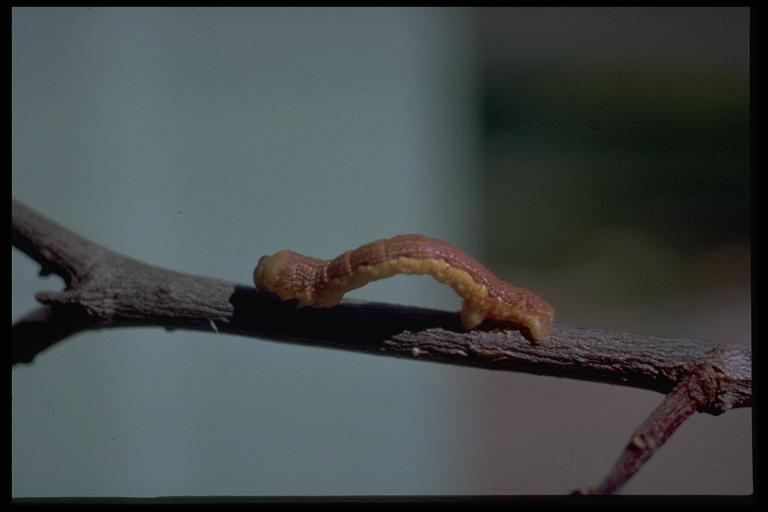
Spring cankerworm, Paleacrata vernata (Peck) (Lepidoptera: Geometridae). Photo by R. Randell.
Common Name: Spring cankerworm
Scientific Name: Paleacrata vernata (Peck)
Order: Lepidoptera
Description: Adult moths are drab gray, delicate with green markings. Males have a wingspread of about 1 inch while the females are wingless. Cankerworms, like other members of this family, often are called “inchworms” because of the way they crawl. They arch their back into a loop, anchor the hind legs and extend the front to move ahead. The spring cankerworm, Paleacrata vernata (Peck), has two pairs of prolegs on the abdomen, while the fall cankerworm, Alsophila pometaria (Harris), has three pairs of abdominal prolegs. Larvae grow to 1 inch, are variable in color and marked predominantly with green, brown and pale yellow longitudinal stripes.
There are many other species of inchworms many of these are cryptically colored. Inchworms may sometimes be confused with loopers which are in the family Noctuidae. Most adult Geometridae have winged females. Wings may be rounded or highly irregular is shape, and dull to brightly colored. Moths in this family often hold their wings together over the back like a butterfly at rest.
Life Cycle: Females can only migrate by walking because they are wingless. Females crawl up the tree trunks and onto branches to lay eggs in clusters of about 100 in bark crevices or on the limbs. The eggs of spring cankerworms hatch in a few weeks while the eggs of the fall cankerworm remain from November until March or April. Both species hatch from eggs in the spring when trees are just reaching budbreak and new foliage is expanding. Larvae feed on leaves for about 3 to 4 weeks before they drop to the ground on silken thread and pupate in the soil. Caterpillars may be blown in the wind to new locations when suspended on silken threads. Cankerworms remain in the soil as pupae until the adults emerge in the spring or fall depending on the species.
Habitat and Food Source(s): Caterpillars have chewing mouthparts. Adults have siphoning mouths. Nearly any broad leaved tree or shrub could be attacked. Oak and elm trees are some of the more commonly attacked trees. Adult males may be seen with blacklights. Adult females may be found on tree trunks as they walk up the tree.
Pest Status: Can be major defoliators of broad leaf trees in east and central Texas with widespread outbreaks occurring in some years; defoliated trees typically survive and leaf out again; caterpillars can be a nuisance when abundant; medically harmless.
Damage: Defoliation of broad leaf trees.
For additional information, contact your local Texas A&M AgriLife Extension Service agent or search for other state Extension offices.
Literature: Jackman 1981.